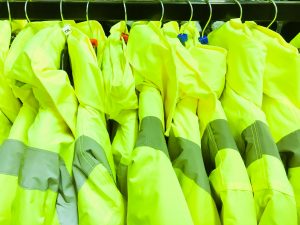The high-visibility vest is the closest thing Australia has to a national dress. It is ubiquitous in the resources and manufacturing industries, and on building sites and roadworks, and as a result in print and television advertisements. It is deemed to be symbolic of who Australians are as people — practical, hardworking, a bit rough around the edges, but always mindful of safety.
Come election time politicians can’t wear enough high-vis vests. It is the costume they choose to try to project their authenticity. It seeks to demonstrate that the politician is in touch with the working man, that they know what the average “Aussie battler” wants and requires. Politicians seem to believe there is a strong correlation between the amount of high-vis they wear and the number of votes they will receive.
For the Labor Party the high-vis vest is an essential component of their historical mission. With its connection to the trade union movement, blue collars have been replaced by fluorescent yellow and orange. The colors may have changed, but whom the party seeks to represent has been consistent — This despite the fact that the party has found much greater support from progressive, middle-class knowledge workers in the past few decades.
For the Liberal Party, the high-vis vest is a strange form of reverse aspirationalism. As the party is coming under extreme pressure in wealthy, educated seats that have previously been its backbone, it is refocusing itself on the outer suburbs of Australia’s major cities, where people often work with their hands instead of in front of a computer. This is part of a noticeable shift in the demographics of who support conservative parties throughout the Western world, as cultural issues are being prioritized over traditional economic advantages or disadvantages.
Yet the high-vis election tactic also seems to be from a bygone era, one where the assumption was that wives would simply vote in line with their husbands and so it was only husbands that politicians needed to persuade. The high-vis imagery is almost exclusively designed to appeal to men. As Australia has compulsory voting, this is not a political calculation that men vote in greater numbers than women. It is simply a reflection of a political culture that doesn’t consider women to be of any great importance.
For the Liberal Party this approach is particularly baffling. At the 2019 election only 35 percent of women voted for the party, compared to 45 percent of men. This percentage is almost certain to drop further at this election, as the last three years have been terrible for the relationship between the Liberal Party and women, with a number of physical and sexual abuse scandals involving the party, and the government often failing to even comprehend why women may feel aggrieved.
Domestic violence remains Australia’s primary security problem, with one woman being murdered every week by a former or current partner. Rates of sexual assault have risen over the past decade, while the conviction rate for perpetrators is an extraordinary 1.5 percent of cases. The family court still favors paternal authority over the safety of women and children.
Alongside these persistent horrors, the COVID-19 pandemic has disproportionately affected women, with more women losing their jobs due to the economic recession, while they have continued to perform most of the essential care work within families, including additional burdens associated with the pandemic like sick relatives and disruptions to children’s schooling. Women were less likely to get government support designed to alleviate the economic stress of the pandemic.
Outside of the pandemic, Australia’s economic structure creates significant barriers to both employment and career advancement. Astonishingly, Australia’s women rank equal first in the world in educational attainment, but 70th in economic participation. An economy based on simply digging stuff up and shipping it overseas is always going to be alienating to women.
It is no coincidence that one of the major threats to the Liberal Party this election is from a loose movement of independent female candidates who are running in previously safe Liberal seats in highly educated suburbs. This movement already replaced former Liberal prime minister – and man of antiquated views at best – Tony Abbott, at the 2019 election, and now it is coming for several other high profile Liberal MPs. These targets are all male MPs, as less than a quarter of the party’s elected representatives are women.
This election campaign has been deemed to be of little substance. The Liberal Party seems to want to simply hold onto power without providing any real justification, while the Labor Party has run a “small target” strategy designed to win solely due to the Liberals’ unpopularity. Because neither major party has articulated any real vision for the country, they’ve both fallen back on the lazy political tactic of endless cosplaying in high-vis vests – making lazy attempts to appeal to the people who have always swung elections in Australia.
Yet when the votes are counted and the analysis of them is conducted, this election will have clearly been about something. It will have been about women’s place in Australian society, and how women will have exercised their vote to shift the parliament in a manner that will hopefully bring them greater opportunity, safety, and respect. While in the final week of the campaign politicians will no doubt continue to wrap themselves in high-vis, come Saturday night when results are tallied it is women who will likely have made themselves seen.

































